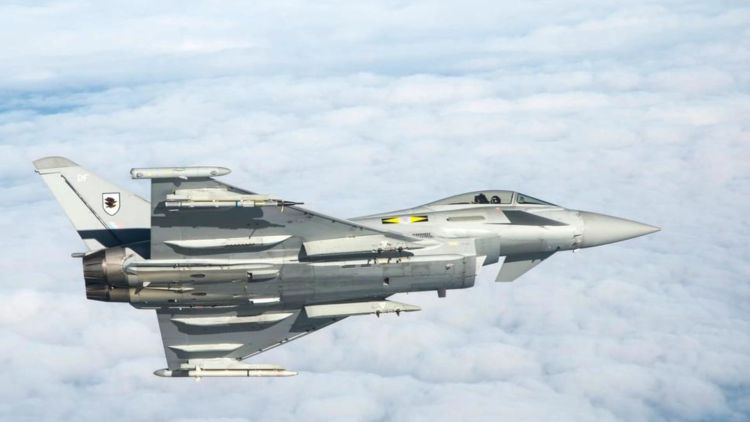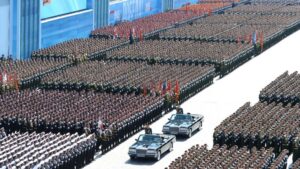Russian airspace control recently detected several aerial targets approaching the state border over the Black Sea. To safeguard national boundaries, an on-duty Su-27 fighter jet from the Air Defense Forces was swiftly scrambled, as detailed by the Russian Ministry of Defense.
The crew of the Su-27 successfully identified the targets as an RC-135 strategic reconnaissance aircraft and two Royal Air Force Typhoon fighters.
Upon the approach of the Russian jet, the foreign aircraft veered away from the Russian border, ensuring no territorial violations occurred.
The Russian fighter jet then returned safely to its base. Throughout this encounter, the Russian Ministry emphasized that the fighter’s flight adhered strictly to international airspace regulations, maintaining safe distances and avoiding any route crossings with the foreign aircraft.
Strategic Reconnaissance in a High-Stakes Environment
The Royal Air Force‘s RC-135 reconnaissance aircraft plays a pivotal role in gathering intelligence over the Black Sea, a region strained by ongoing conflicts, notably between Russia and Ukraine.
This intelligence is crucial for the UK and its allies to monitor Russian military movements and strategies effectively. By understanding Russian operations, especially those concerning naval and air forces, allied nations can better predict potential military actions, enhancing their readiness and strategic planning.
Deterrence and Intelligence Sharing
Operating these reconnaissance missions over the Black Sea serves multiple strategic purposes. Firstly, it acts as a deterrent by maintaining a persistent surveillance presence, signaling a commitment to monitor and counter any aggressive maneuvers by Russia.
This ongoing vigilance helps to stabilize the region by deterring escalatory actions and keeping Russian ambitions in check. Furthermore, the intelligence gathered by RC-135 aircraft is not solely for national use. It is shared with NATO and allied countries.
This collaborative intelligence effort bolsters the collective security awareness and preparedness of all involved nations, reinforcing the security framework in the Black Sea region.
Versatility of the RC-135 Aircraft
The RC-135 is a versatile family of reconnaissance aircraft used primarily by the United States Air Force and the Royal Air Force. Originating from the C-135 Stratolifter airframe, these aircraft have been extensively modified to carry out intelligence, surveillance, and reconnaissance (ISR) missions. The most well-known variant, the RC-135V/W Rivet Joint, is equipped with a sophisticated sensor suite capable of detecting, identifying, and geolocating signals across the electromagnetic spectrum. This information is then rapidly disseminated to various consumers, including theater commanders and national intelligence agencies. The Rivet Joint has been a crucial asset in numerous operations, including Desert Storm, Enduring Freedom, and the ongoing operations in the Middle East .
The US RC-135 fleet, which is permanently based at Offutt Air Force Base, Nebraska, is operated by the 55th Wing. These aircraft have seen action in every major U.S. conflict since the Vietnam War, demonstrating their importance in both tactical and strategic roles. Recent deployments have included missions over Poland and the Baltic region to monitor Russian military activities during the 2022 Russian invasion of Ukraine. The RC-135’s capability to provide real-time intelligence has made it an indispensable tool for modern military operations, and ongoing upgrades ensure it remains at the forefront of ISR technology.
The RC-135 is not just another aircraft; it is a cornerstone of modern aerial surveillance with a rich history of service since the 1960s. The aircraft’s design allows for extensive modifications and upgrades, which have kept it at the forefront of intelligence, surveillance, and reconnaissance (ISR) missions.
An F-15E Strike Eagle assigned to the 494th Fighter Squadron. (U.S. Air Force photo by Airman 1st Class Rhonda Smith / DVIDS)
With a comprehensive suite of surveillance systems, including SIGINT, ELINT, and COMINT capabilities, the RC-135 can adapt to a variety of intelligence needs, making it an invaluable asset in the dynamic landscape of international security challenges, particularly those posed by the Russia-Ukraine conflict.
Advanced Capabilities and Safety Features
In addition to its versatile mission profile, the RC-135 boasts advanced avionics and navigational systems that ensure precise operations and maximal mission effectiveness. Equipped with GPS, inertial navigation systems, and tactical data links, it ensures real-time data sharing and accurate positioning crucial for complex surveillance tasks.
Its sophisticated autopilot systems and redundant flight controls enhance safety, making the RC-135 a reliable choice for high-stakes missions. This aircraft represents a significant investment in the capability to conduct comprehensive surveillance, offering a strategic advantage by providing timely and accurate intelligence to decision-makers.
By hosting these advanced reconnaissance operations, the RC-135 and its crew continue to play a critical role in shaping the security dynamics of the Black Sea, supporting peace and stability through vigilant monitoring and strategic intelligence gathering.
__
Disclaimer: SOFREP utilizes AI for image generation and article research. Occasionally, it’s like handing a chimpanzee the keys to your liquor cabinet. It’s not always perfect and if a mistake is made, we own up to it full stop. In a world where information comes at us in tidal waves, it is an important tool that helps us sift through the brass for live rounds.



